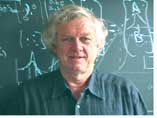 |
| Course instructor, Dr. F. M. Tesche. |
For the past several years, the IEEE Electromagnetic
Compatibility (EMC) Society has funded a $10,000 grant to recognized
educational institutions for the purpose of assisting in the establishment
of a course in the ECE curriculum that addresses principles of
and design practices for EMC. The 2002 grant was awarded to Clemson
University. This article briefly describes the IEEE grant program
and provides some details of the highlights of the EMC course
that was given in the spring of 2003 at Clemson as a direct result
of this grant.
Clemson University has long had a strong electromagnetics program.
Unlike at many institutions, electrical engineering undergraduates
at Clemson must take two courses in electromagnetics to graduate.
In addition, students have the option of taking courses in Microwave
Circuits, Antennas and Propagation, and Fiber Optics as technical
electives. Dr. F. M. Tesche, a research professor at Clemson,
and Prof. C. M. Butler saw that the addition of a formal course
in electromagnetic compatibility (EMC) at Clemson would be an
excellent addition to the existing electromagnetics program. They
believed that an EMC course would complement the electromagnetics
curriculum by providing a practical application side to the program’s
mostly theoretical coverage.
Consequently, when the announcement for proposals for the 2002
award was made, they decided to make a bid for this grant and
stated that, if it were awarded to their university, they would
conduct an EMC course in the spring of 2003 at Clemson.
The requirements for applying for this grant were rather straightforward
and involved submitting the following items to the EMC Society:
• A budget (direct and indirect costs
as well as university cost sharing)
• A detailed syllabus containing a proposed course outline
by class lecture
• Any experiments/demonstrations to be used or developed
• A description of any materials or software to be developed
In discussions with the ECE Department Chairman,
Prof. John Gowdy, they were able to obtain a matching commitment
of $10,000 in department funds to support their proposed course.
This was above and beyond the normal instructor salary typically
paid for teaching courses at Clemson.
This information was put together into a short proposal and submitted
to the IEEE EMC Society for their evaluation and consideration.
Much to their surprise (and delight), Mr. John Howard notified
them in early June of 2002 that their proposal was accepted and
that they would receive a check at the 2002 IEEE International
Symposium on Electromagnetic Compatibility held in Minneapolis,
Minnesota. Unfortunately, prior travel commitments to the Zurich
EMC Symposium organization committee meeting precluded attending
the Minneapolis meeting. However, Dr. Bud Hoeft kindly agreed
to accept the award on behalf of Clemson (and forward the check
promptly to the University).
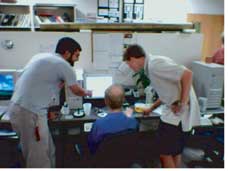 |
| Graduate assistant, Jason Keen (left),
assists two EMC class students with a MathCAD simulation of
cable cross talk. |
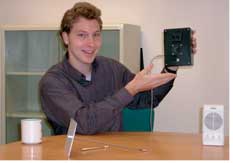 |
| Graduate student Mike Lockard proudly
shows his Theremin device, which audibly demonstrates the
effects of component lead lengths. |
With support from the IEEE EMC Society and Clemson’s Holcombe
Department of Electrical and Computer Engineering, Dr. Tesche
proceeded with the development of the course ECE 493/693, entitled
“Introduction to Electromagnetic Compatibility,” and
in the spring of 2003, this course was offered to seniors and
graduate students at Clemson University. In addition, several
auditors attended the course.
Of course, deciding to offer a new course is only the first step
in the course development. One also must decide upon a set of
goals for the course and plan how to accomplish them. In summary,
the goals of the EMC course were to explain and illustrate the
basic principles of electromagnetic compatibility, to expose students
to a variety of EMC resources which might be useful in their future
careers, and to provide the students with an opportunity to develop
the necessary skills to conduct original research in the EMC area
(including the ability to communicate their results in both written
and oral formats).
In the development of the course outline, the field of EMC was
broken into four subtopics: fundamental concepts, EMI effects
on components and systems, EMC design, and EMC specifications
and compliance testing. For the purpose of covering the fundamental
concepts, the key models for conducted emissions, conducted susceptibility,
radiated emissions, and radiated susceptibility were discussed.
In addition, topics related to advanced transmission line models
and EMC shielding were covered as part of this subtopic. The result
was that this was by far the bulk of the course as Dr. Tesche
tried to provide his students with a solid understanding of the
material, preparing them for reading the literature in the future.
Through a solid coverage of this material, students were better
prepared to address the issues of EMC design and specifications
in the last third of the course.
To enhance the learning experience, a significant array of resources
was made available to the students during this course. The class
lectures were conducted exclusively in PowerPoint and, at the
end of each lecture, the course vugraphs were provided to the
students in e-format. A variety of EMC textbooks and handbooks
were purchased from grant money and were made available to the
students; at the end of the course they were donated to the university
library.
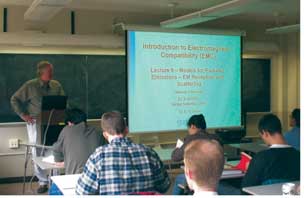 |
| Typical classroom scene for the ECE
493/693 EMC course at Clemson University in Spring 2003. |
In addition, a course website was developed.
This extensive website included a variety of journal articles
relating to topics covered in the EMC course and an extensive
collection of class notes. In fact, not only did students have
access to the class notes developed by Dr. Tesche, but also to
EMC notes written by Prof. Ed Rothwell at Michigan State University
(with permission). So as to provide the students with continuing
access to these resources, a CD containing the complete content
of the webpage was produced at the end of the course and provided
to each student.
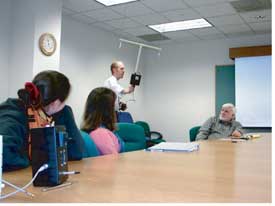 |
| Prof. Butler (right) listens intently
to graduate student Jeremy Rudbeck as he demonstrates direction-finding
principles to the class. |
As part of the goal to improve student research
skills, Dr. Tesche decided to broaden their computational toolbox.
Using money provided by the matching ECE Department grant, he
bought a site license and provided a copy of MathCAD to each student
in the class. Homework and projects were then assigned which utilized
the MathCAD package for computational purposes. For these and
other projects, students then wrote reports and prepared presentations.
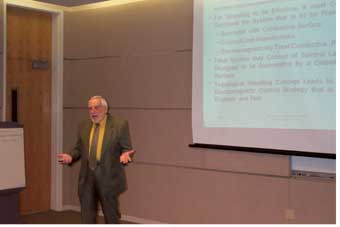 |
| Past IEEE EMC Society Distinguished
Lecturer, Dr. Bud Hoeft, presents his invited lecture at the
Clemson IEEE meeting, held in conjunction with the EMC course. |
One of the more extensive sets of projects was
done in conjunction with students participating in an ECE 892
seminar course taught by Prof. Butler, also in the spring semester.
In this conjoined course, students developed a variety of EMC
demonstration projects, which were presented to the collected
students in the ECE 493/693 EMC course via a PowerPoint presentation.
These demonstrations were also documented in short reports, which
were made available to the students. Assisting with these student
projects, as well as with other aspects of this EMC course was
Jason Keen, a graduate student in the ECE Department.
These projects provided simple and real-world insight into the
relevance of EMC to an electrical engineer in the modern world
and involved the following topics:
-
Investigation of Ground Noise in Digital
Logic
-
Effect of Pulse Rise/Fall Time on Signal
Spectra
-
Locating RF Interference using a Dual-Dipole
Switched Array
-
Effects of Component Lead Lengths and Environmental
Conditions on Oscillator Frequency: Theremin Demonstration and
Discussion
-
Crosstalk in Cables
-
Electrostatic Discharge
-
Electromagnetic Leakage through Seams
In addition to the formal part of the EMC course,
the grant from the EMC Society allowed Dr. Tesche to bring in
several external lecturers to the IEEE-sponsored campus meetings.
Students in the EMC course were strongly encouraged to attend
these extra curricular meetings. Keeping to the EMC theme, each
of these speakers provided different views of the very broad area
of EMC. The following speakers kindly agreed to participate in
this program:
Dr. D. V. Giri, Pro-Tech, Radiation of Impulse-like Waveforms
with Illustrative Applications, presented on March 24, 2003.
Dr. L. O. (Bud) Hoeft, Consultant, Electromagnetic Effects, How
Electromagnetic Energy Penetrates Conductive Barriers: Electromagnetic
Shielding of Cables, Connectors and Enclosures, presented on April
8, 2003.
Dr. Carl E. Baum, Air Force Research Laboratory, Application of
Concepts of Advanced Mathematics and Physics to the Maxwell Equations,
and High-Power Electromagnetic Radiators, presented on April 22,
2003.
Due to the support of the IEEE EMC Society, a new course was brought
to Clemson University and its students. This support also allowed
Clemson to improve and update its collection of EMC technical
resources and to invite noted speakers to provide their knowledge
and insight to Clemson students. All of the students who benefited
from this course appreciate the support provided by the EMC Society.
It is hoped that the EMC Society will continue this important
educational program. EMC
The Icing on the Cake!
 The
new course on Electromagnetic Compatibility developed
by Dr. Fred Tesche was a major enhancement to the electromagnetics
curriculum in the Department of Electrical and Computer
Engineering at Clemson University. We are grateful to
the IEEE Electromagnetic Compatibility Society for providing
financial support to make the development of this course
possible. I am also very pleased that our ECE Department
was able to provide cost sharing support to maximize the
output of this endeavor. The
new course on Electromagnetic Compatibility developed
by Dr. Fred Tesche was a major enhancement to the electromagnetics
curriculum in the Department of Electrical and Computer
Engineering at Clemson University. We are grateful to
the IEEE Electromagnetic Compatibility Society for providing
financial support to make the development of this course
possible. I am also very pleased that our ECE Department
was able to provide cost sharing support to maximize the
output of this endeavor.
Our EM program is blessed with outstanding senior leadership
in the persons of Profs. Chalmers Butler and Wilson Pearson.
Other key contributors to the program include Profs. Xiao-Bang
Xu, Anthony Martin, and Michael Bridgwood. This group
is known not only for their outstanding research accomplishments
and professional society activities, but also for their
excellence in teaching and their dedication to curriculum
enhancement. We were very pleased when Dr. Tesche relocated
to the Carolinas and was therefore able to strengthen
our already strong EM faculty group.
For many years, Applied Electromagnetics has been one
of the graduate research focus areas of our Department.
EM is, of course, also a fundamental part of our undergraduate
Electrical
Engineering program, and two three-credit junior level
courses
are required for all EE majors. Our curriculum also includes
senior level elective courses on Microwave Circuits, on
Antennas and Propagation, and on Fiber Optics. Our graduate
program includes eight three-credit courses and a one-credit
seminar course in advanced aspects of EM. The EM graduate
program has been consistently successful in attracting
top students to study and perform research in this area.
The new course developed by Dr. Tesche was the “icing
on the cake” of an already strong program in the
EM area. The course was targeted primarily for graduate
students, but was also available to advanced undergraduates.
Student feedback indicates that the course was highly
successful and presented a major addition the curriculum.
Dr. Tesche not only did an excellent job of developing
the course, but also carefully documented his course materials
on a CD ROM to facilitate future presentations of the
course.
Dr. John N. Gowdy
Professor and Chair
Electrical and Computer Engineering Department
105 Riggs Hall
Clemson University
Clemson, SC 29634-0915
Telephone: 864 656 5249
FAX: 864 656 5917
jgowdy@clemson.edu
|
|
|
|






 The
new course on Electromagnetic Compatibility developed
by Dr. Fred Tesche was a major enhancement to the electromagnetics
curriculum in the Department of Electrical and Computer
Engineering at Clemson University. We are grateful to
the IEEE Electromagnetic Compatibility Society for providing
financial support to make the development of this course
possible. I am also very pleased that our ECE Department
was able to provide cost sharing support to maximize the
output of this endeavor.
The
new course on Electromagnetic Compatibility developed
by Dr. Fred Tesche was a major enhancement to the electromagnetics
curriculum in the Department of Electrical and Computer
Engineering at Clemson University. We are grateful to
the IEEE Electromagnetic Compatibility Society for providing
financial support to make the development of this course
possible. I am also very pleased that our ECE Department
was able to provide cost sharing support to maximize the
output of this endeavor.